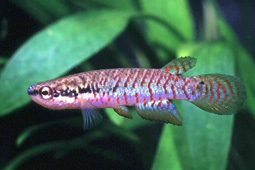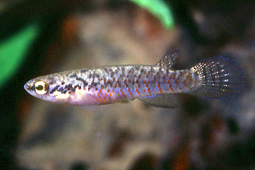History
Alternative name Melanorivulus apiamici.
Rivulus apiamici is a member of the subgenus Melanorivulus. Costa was also the author of the paper describing 4 other species from that region as well. It was seen, by some scientists, as a synonym of Melanorivulus pictus. It is only known from the type locality Bataguaçue, close to the state border, Mato Grosso du Sul, Brasil.
The name refers to the Tupi- Indian expression <apaima> which means a row or line and <ici> with reference to the chevron-like shape of these markings on the male's sides.
The species was discovered by Percio Souza Santos Filho in 1975. It belongs to a super species group that contains also Rivulus cyanopterus, R. dapazi, R. decoratus, R. egens, R. kapayo, R. litteratus, R. modestus, R. paracatuensis, R. parnaibensis, R. pictus, R. pinima, R. punctatus, R. rossoi, M. rutilicaudus, R. scalaris, R. violaceus, R. vittatus and R. zygonectes. Research is needed and also crossing programmes with species like the closely related R. pictus and others in the group. We need more information as to the distribution of this species.
Reproduction
Keeping and breeding is easy but a tight fitting cover on the aquarium is necessary because their ability to jump, even through the smallest opening, is unbelievable.
This species can, if there is enough space for them, be housed in a tank with more than one male and several females. If separated before and brought together again however, they can be very aggressive towards each other and fight to become the dominant fish. The best way to produce numbers of fry is to put a pair or a trio in a small tank of about 10 litres with a small filter in it or with some aeration. On the bottom of the tank place some peat moss or dark gravel and a floating "mop" to give space for laying their eggs. The fish will, if they are fed a rich variety of live food, spawn during their whole adult life and produce daily between 5 to 10 eggs.
The eggs should be collected by hand and stored for about 14 days in a small container. Eggs are 1.5 mm and amber coloured. It is wise to add an anti fungus to the water you store the eggs in, to prevent fungal attacks.
After hatching the young fry can eat fresh artemia nauplii without any problem. It takes 4 to 5 months to raise them to maturity. Often the males far out number females. For some species this can become a major problem for the breeder, as he has to raise many fry to enable distribution of a few pairs to other hobbyists. Recent personal tests found that lower pH levels during the time of hatching gave a higher percentage of females. To achieve this I used some peat moss that I added to the container with the eggs just before they were ready to hatch. This peat moss also is a good way to prevent eggs from being attacked by fungus.
Their lifespan can be up to 2 years in captivity.
Remarks :
It seems that Melanorivulus apiamici has disappeared from the hobby and is not available anymore and will remain so until and unless a new collection takes place.
Variations
Map
Meristics
Max. size 5.0 cm.
Dorsal 8.5,
Anal 13.8,
D/A 9.5
LL scale count (average)30.5
Pre- dorsal length to % SL – 80.6 %
Literature
Costa, W.J.E.M. 1989. Descricao de cinco Especies de Rivulus das Bacias dos Rios Parana e Soa Francisco (Cyprinodontiformes, Rivulidae). Revta. Bras. Zool., 6 (3): 527, figs. 3-3a.

